This Easy and Quick Ratatouille Recipe is packed with plant-based and vegan-friendly fresh ingredients that are typical of Provençal French cooking. This rustic Ratatouille stew can be cooked in about 30 minutes and results in a delicious veggie stew juices which can be mopped up with a chunk of crusty bread. Not a fan of aubergines [aka eggplants]? Then simply omit and use more of the other vegetables for the best no-aubergine ratatouille! Also as a disclaimer: no tomatoes were skinned in the making of this ratatouille!

This easy Ratatouille recipe can be adapted to your preferences. If you don't like aubergines [eggplant] or perhaps courgettes [zucchini] then simply omit and add more of the ingredients that you do enjoy. Alternatively, chunks of yellow summer squash, vegetable marrow, juicy meaty mushrooms or even cubes of tofu can replace the aubergine.
Origins of Ratatouille
Ratatouille is a traditional French Provençal vegetable stew which originated around 18th century Nice. The word "ratatouille" is derived from the old Occitan word "ratatolha", which means "to stir up the chunky stew'' and it also derives from the French verb "touiller," which means to ''toss'' or'' stir''.
This refers to the stirring of the individual vegetables that make up the chunky stew, as old traditional Ratatouille recipes would cook each vegetable on its own before tossing together with herbs and seasonings.
Dishes similar to Ratatouille are popular in many Mediterranean countries, such as the Spanish dish Pisto and the Italian dish Caponata.
Ratatouille was initially a simple peasant stew that was prepared with the native Mediterranean vegetables and herbs. The main ingredients in ratatouille are tomatoes, garlic, onions, zucchini [courgettes], eggplant [aubergine], bell peppers, and various herbs, especially parsley and basil.
It was not until the 20th century that ratatouille gained international recognition. Julia Child [1912-2004], the famous American cook, introduced French cookery to an American audience through her television show ''The French Chef'' which aired in 1963, and the recipe Ratatouille through her book "Mastering the Art of French Cooking" in 1961.
Although subsequent recipes for ratatouille were included within Julia's other books including ''The French Chef Cookbook'' [1979] where Julia refers to a ratatouille as a ''French Casserole'' and the eggplant as ''one of our handsomest vegetables''! [pg59].
Julia and her French recipes were a huge success and ratatouille was soon making a popular appearance at many dinner parties throughout the 60s and 70s.
Ratatouille has appeared in popular culture in various ways but most notably, the dish was the star of the 2007 Disney-Pixar film "Ratatouille." The movie tells the story of a rat named Remy who aspires to become a chef and tries to achieve his goal by forming an friendship with the restaurant's janitor.
The film concludes with Remy preparing a gourmet version of Ratatouille, which pleases a hard-to-please food critic. This version of Ratatouille, a confit byaldi, was created by Chef Thomas Keller especially for the film, and is now often associated with ratatouille due to the movie's popularity.
Although chef Michel Guérard is credited with originally giving Ratatouille a makeover so that it fitted in with his Novella Cuisine, which created lighter versions of traditional French recipes, the Ratatouille it was chef Thomas Keller who again adapted that lighter version so that it fitted the aesthetics of the animation film.
What is French Provençal Cooking?
French Provençal cooking is a style of cooking that originated in the Provence region of France. It is characterized by its use of fresh, seasonal ingredients, such as tomatoes, olives, herbs, and seafood. Provençal cooking is also known for its use of olive oil, garlic, and spices.
The origins of Provencal cooking can be traced back to ancient times, influenced by various civilizations and cultures that have occupied the region throughout history.
The culinary traditions of Provence have been shaped by the ancient Greeks, Romans, and Gauls who inhabited the area. The Romans, in particular introduced ingredients such as olives, grapes, and herbs, and influenced the agricultural practices in the region.
Some of the most famous Provençal dishes include ratatouille, bouillabaisse, and pissaladière. Bouillabaisse is a fish stew made with a variety of fish, shellfish, and tomatoes. Pissaladière is a flatbread topped with onions, tomatoes, anchovies, and olive oil.
Provençal cooking is a healthy and flavorful style of cooking that is perfect for the summer. It is also a great way to use up fresh, seasonal ingredients which are often less expensive.
Here are some of the most common ingredients used in Provençal cooking:
Tomatoes: Tomatoes are a staple ingredient in Provençal cooking. They are used in a variety of dishes, such as ratatouille, bouillabaisse, and pistou.
Olives: Olives are another important ingredient in Provençal cooking. They are used in a variety of dishes, such as tapenade, salad Niçoise, and pissaladière.
Herbs: Herbs are used extensively in Provençal cooking to add flavour and aroma to dishes. Some of the most common herbs used in Provençal cooking include thyme, rosemary, oregano, and basil.
Seafood: Seafood is a popular ingredient in Provençal cooking. It is often used in dishes such as bouillabaisse, soupe de poissons, and pan bagnat.
Olive oil: Olive oil is a staple ingredient in Provençal cooking. It is used for cooking, dressing, and drizzling.
Garlic: Garlic is a popular ingredient in Provençal cooking. It is often used in dishes such as ratatouille, soupe au pistou, and aioli.
Spices: Spices are used in moderation in Provençal cooking. Some of the most common spices used in Provençal cooking include saffron, fennel, and black pepper.
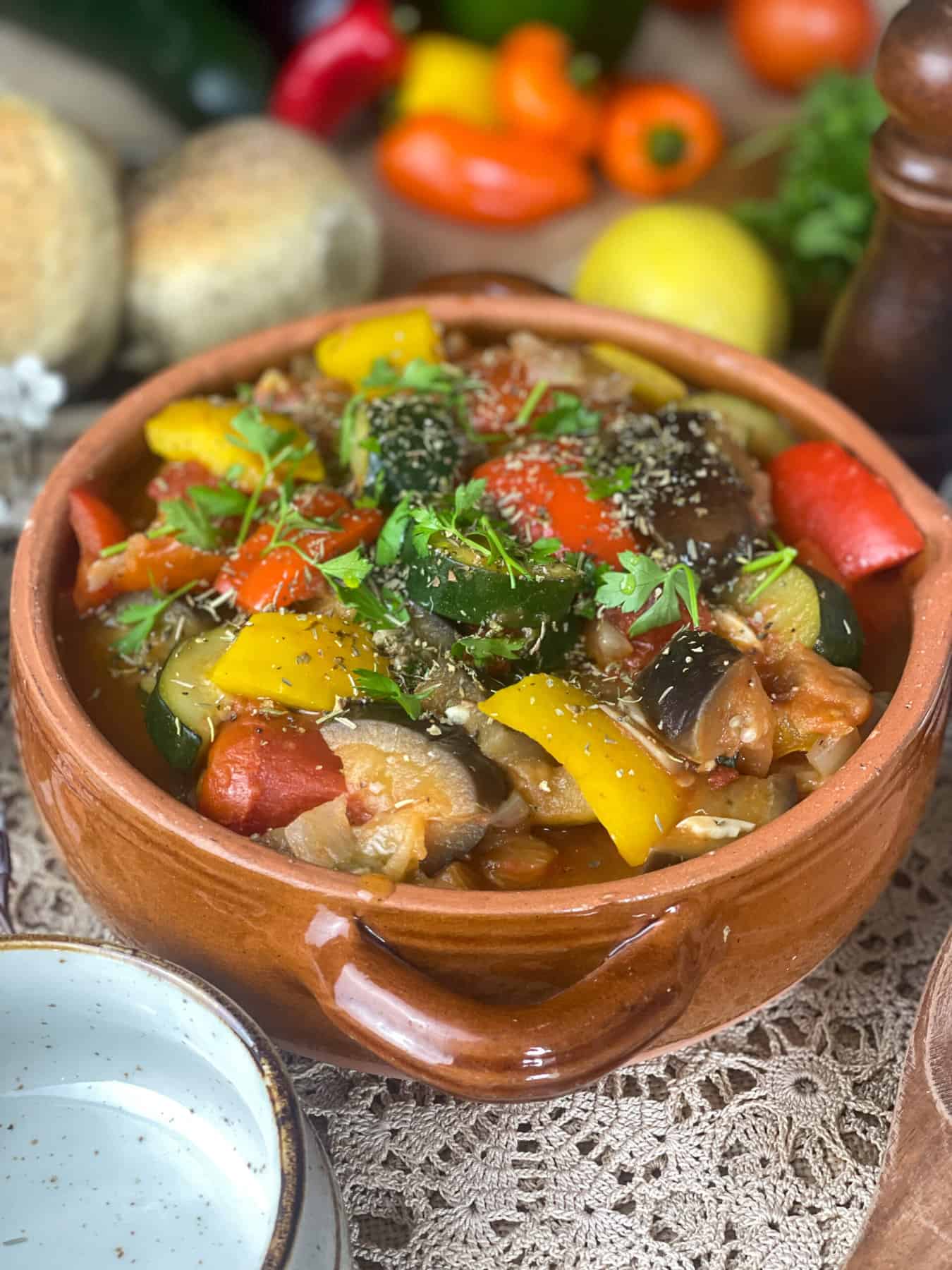
There's nothing better than a bowl of home-cooked delicious fresh veggies stewed to perfection and flavoured with fresh and dried herbs. This naturally plant-based ratatouille makes for the best summer vegetable stew as its just so refreshing and light to eat.
Traditional Ratatouille preparation
Preparing a traditional ratatouille involves a methodical approach to ensure each vegetable shines in the final dish. While there are slight variations depending on the specific recipe or chef, the general method is as follows:
- Separate Cooking: Each vegetable (eggplant/aubergine, zucchini/courgettes, bell peppers, and tomatoes) is cooked separately in olive oil until it's tender before they are all combined. This is done to ensure that each vegetable retains its own flavour.
- Layered Cooking: Some chefs advocate for a particular order in which to cook the vegetables to optimize their flavours. Typically, onions and garlic are sautéed first, followed by bell peppers, then aubergines and courgettes, and finally the tomatoes are added.
- Slow Cooking: The vegetables are then left to stew together over low heat for a lengthy period. This slow, gentle cooking allows the flavours to meld together while keeping the integrity of each vegetable.
- Herbs and Seasoning: Classic herbs used in ratatouille include thyme, bay leaf, and basil. These are added during the cooking process, and fresh basil is often added just before serving as well. The dish is also seasoned with salt and pepper.
- Resting Time: After cooking, traditional ratatouille is often left to sit for a while, sometimes until the next day, to allow the flavors to develop further. It can be served hot, at room temperature, or even cold, and it's often even better the day after it's made.
However, as there are so many different methods and variations on how to cook a ratatouille it is possible to prepare an acceptably delicious ratatouille using easier and quicker methods. Although, if you would like to follow the traditional method then feel free to do so with the ingredients listed below in the recipe card. It can be a fun cook especially if you have longer time to spare in the kitchen. Do let us know how your ratatouille turned out as we love hearing from you. Thanks! Jacq x

How to prepare Quick and Easy Ratatouille
This easy Ratatouille recipe is a simple, quick and rustic version of the traditional French peasant stew.
There is no need to skin and deseed the tomatoes, which is somewhat time-consuming and fiddly, as the tomatoes can be simply chopped and added to the stew along with the courgettes, aubergines, red bell pepper, onions and garlic.
Also the aubergine does not need to be sprinkled with salt to remove excess liquid and the vegetables do not need to be cooked in separate pots.
Its just a simple, fuss-free rustic ratatouille!
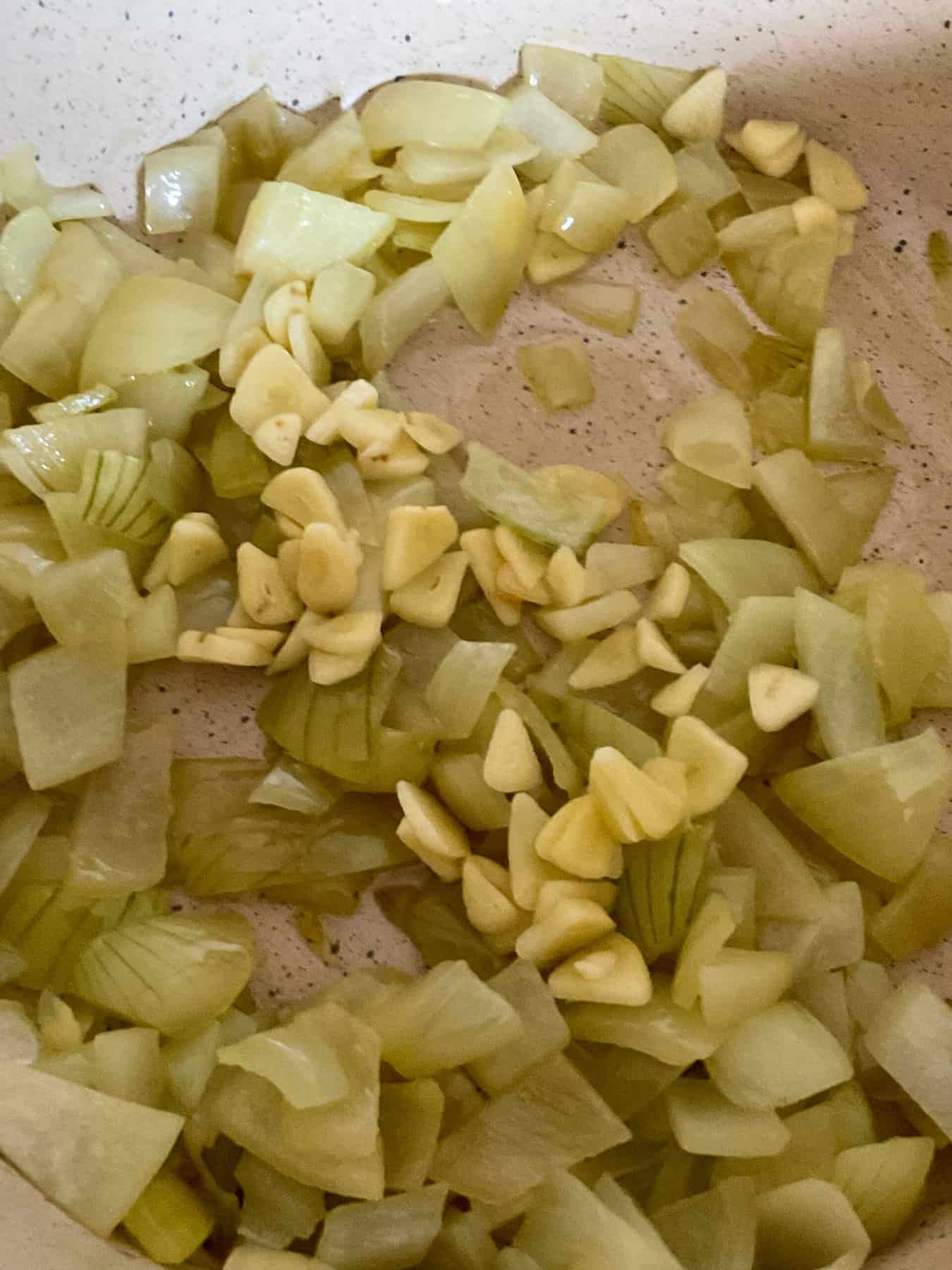
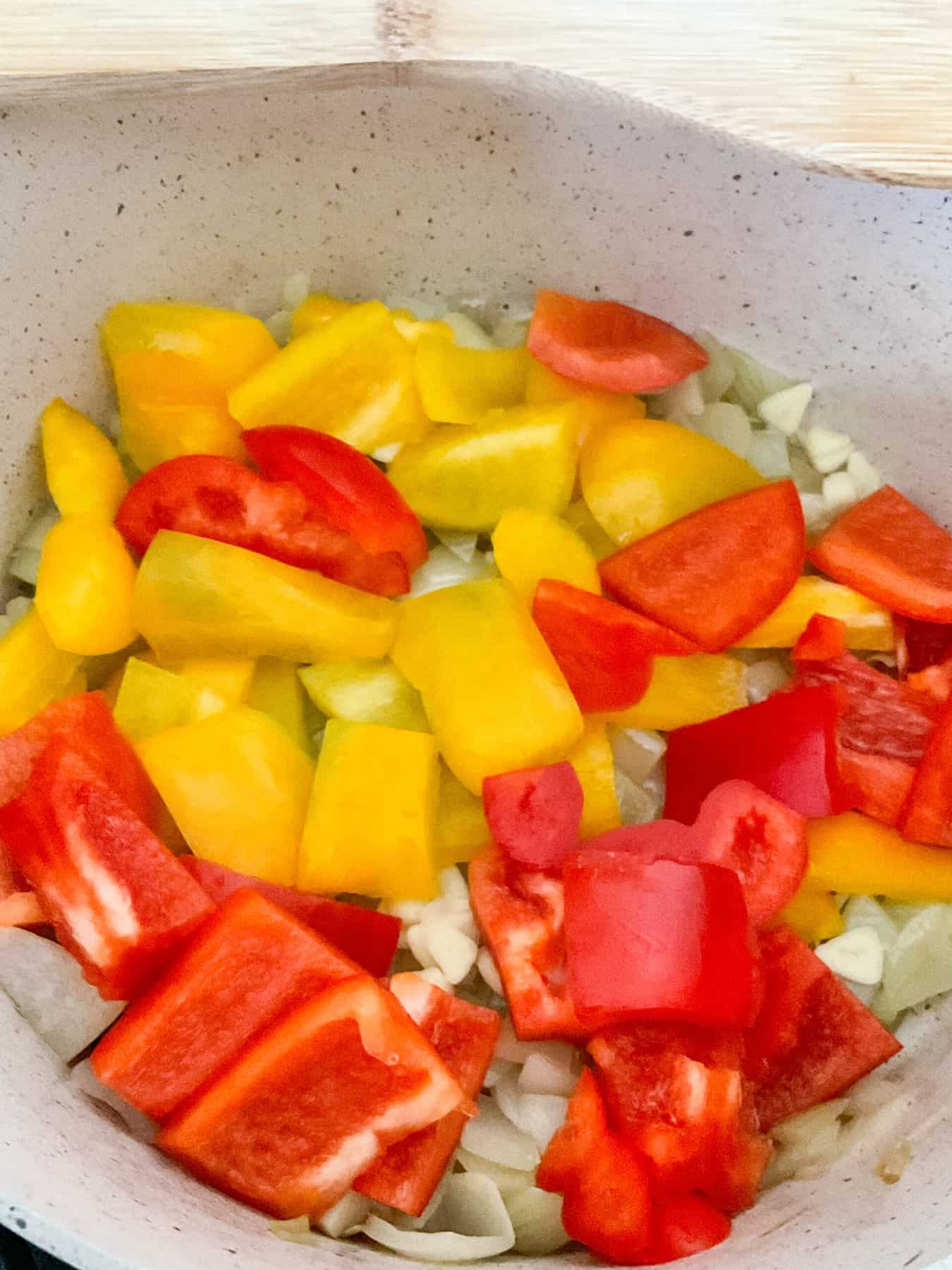
First, cook the onions in olive oil for 5 minutes, before adding the sliced garlic and bell pepper chunks.
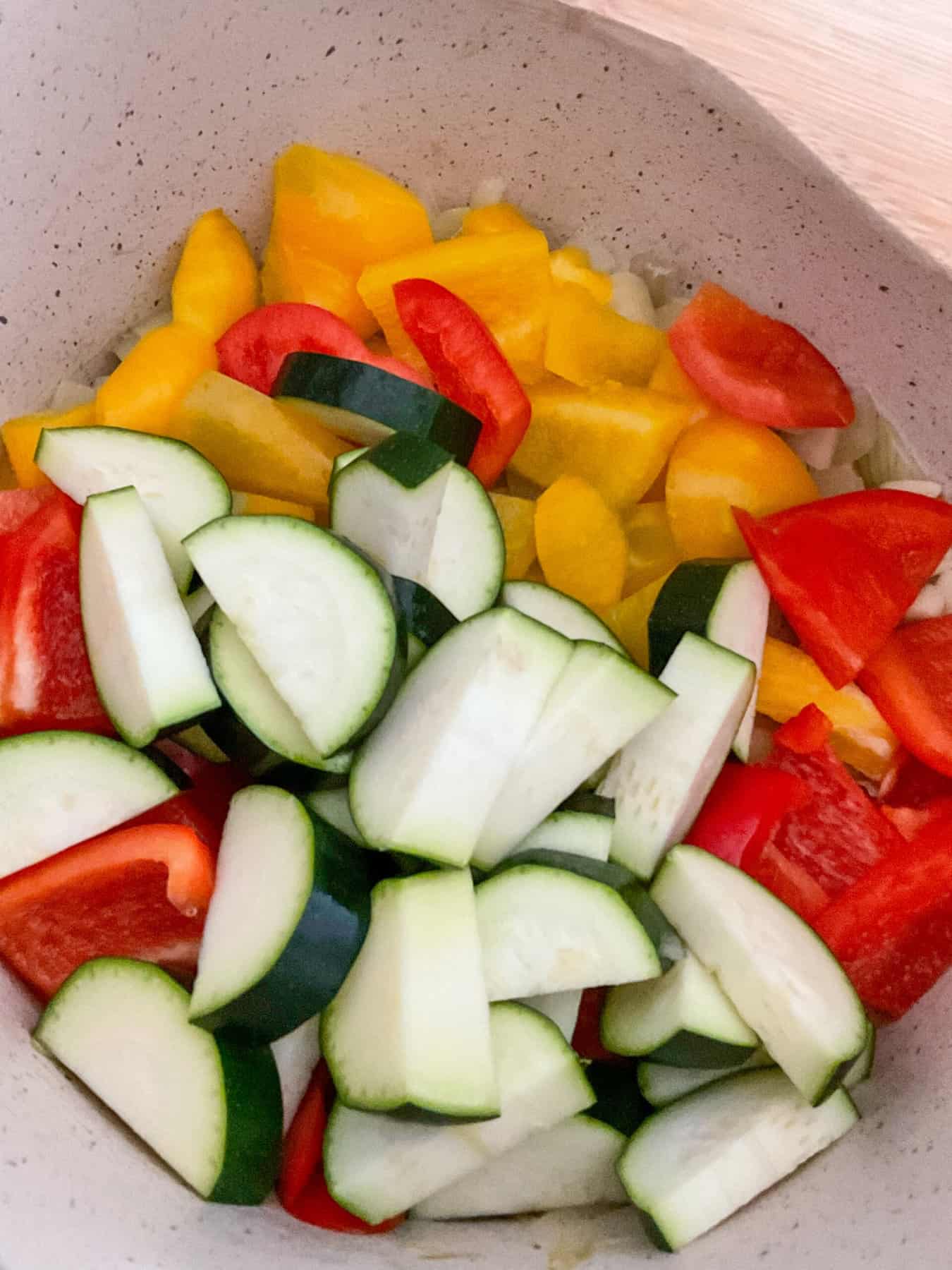
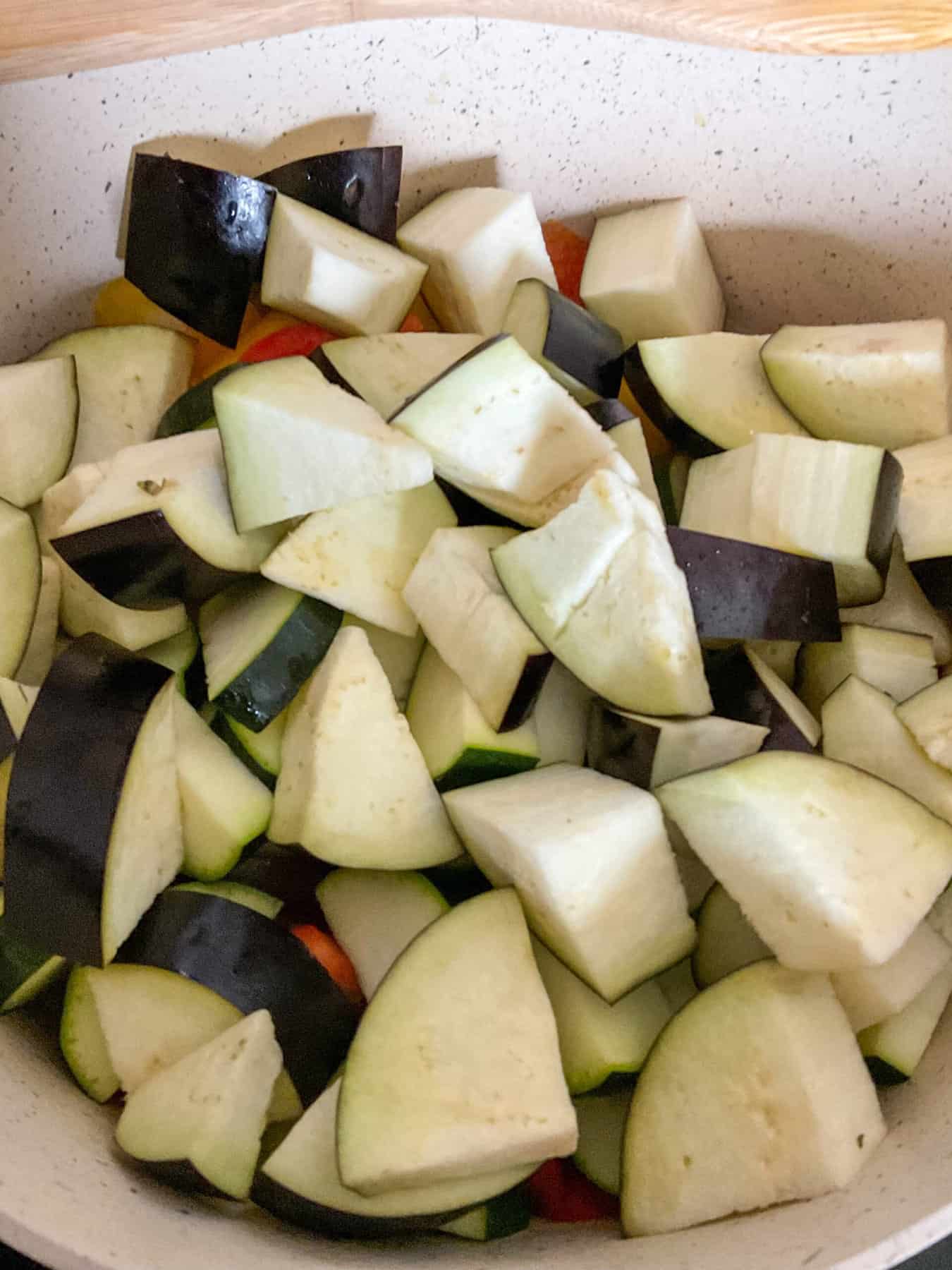
Next, add the courgette chunks and the aubergine chunks.
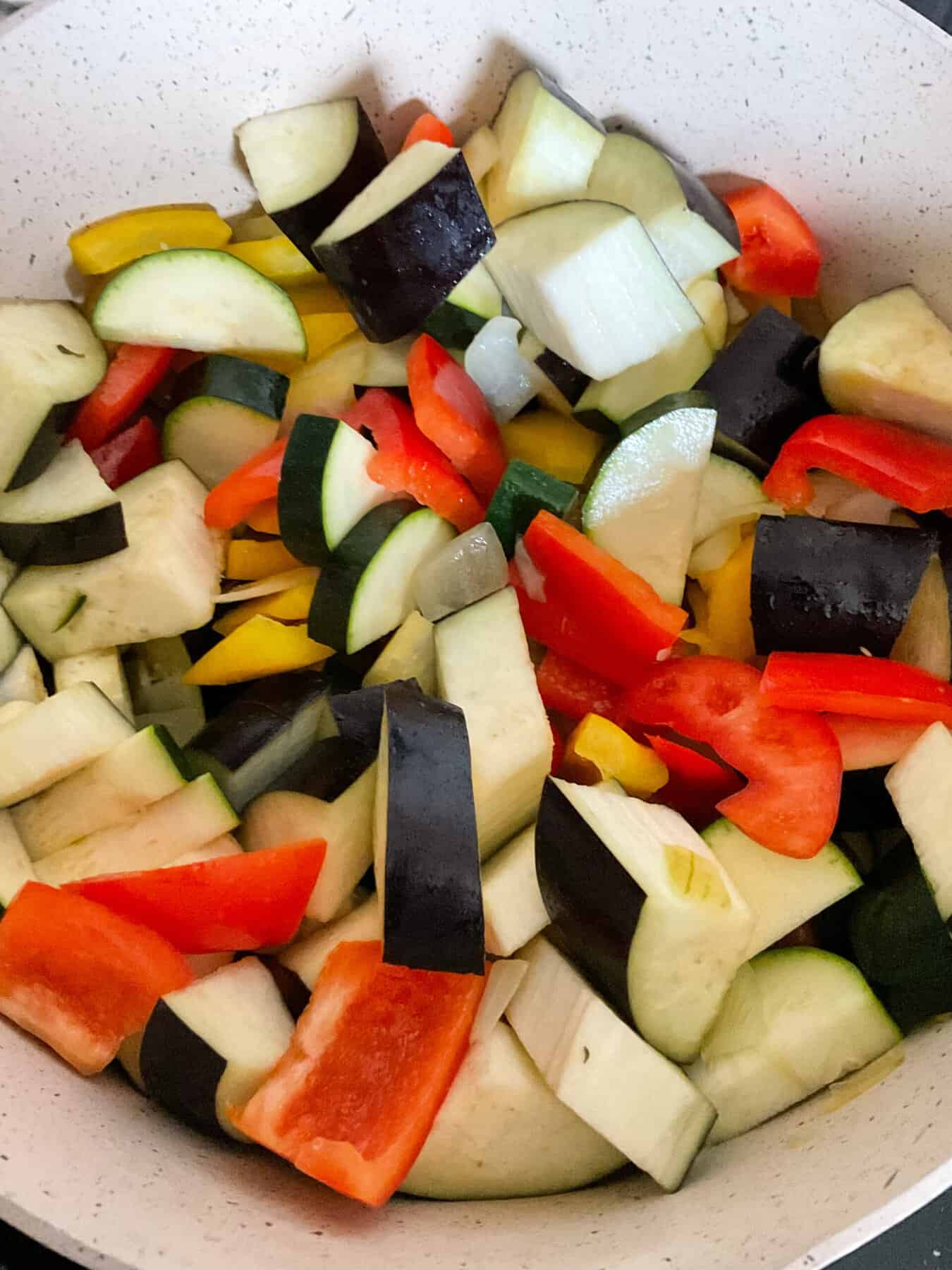
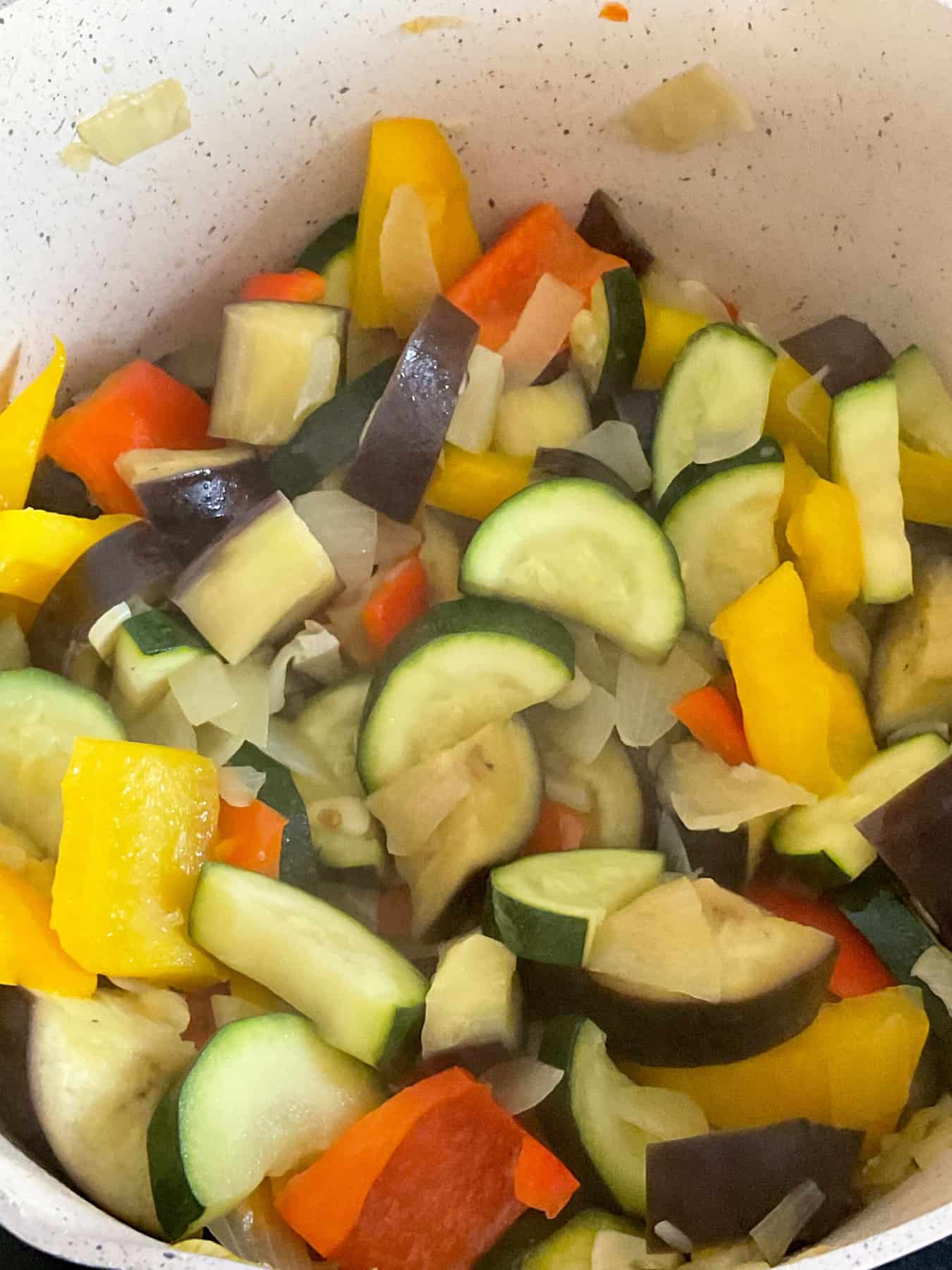
Give it all a good mix and cook with the lid on the pot for 10 minutes, stirring frequently.

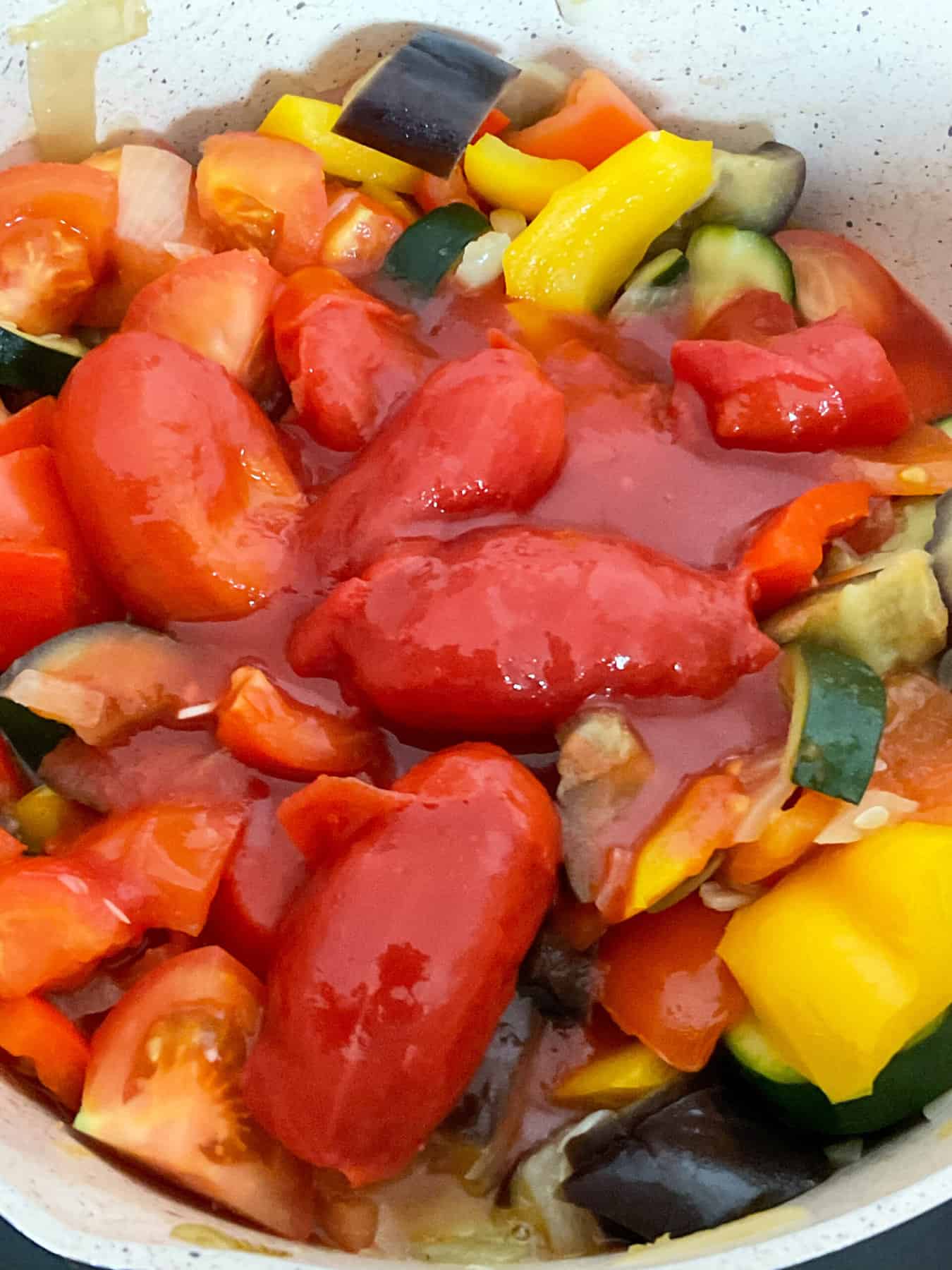
Next, pop in the fresh chopped tomatoes and place the lid back onto the pot, and cook for a further 5 minutes. Remove the lid and add the can of plum tomatoes and cook for an additional 5 minutes with the lid off the pot.
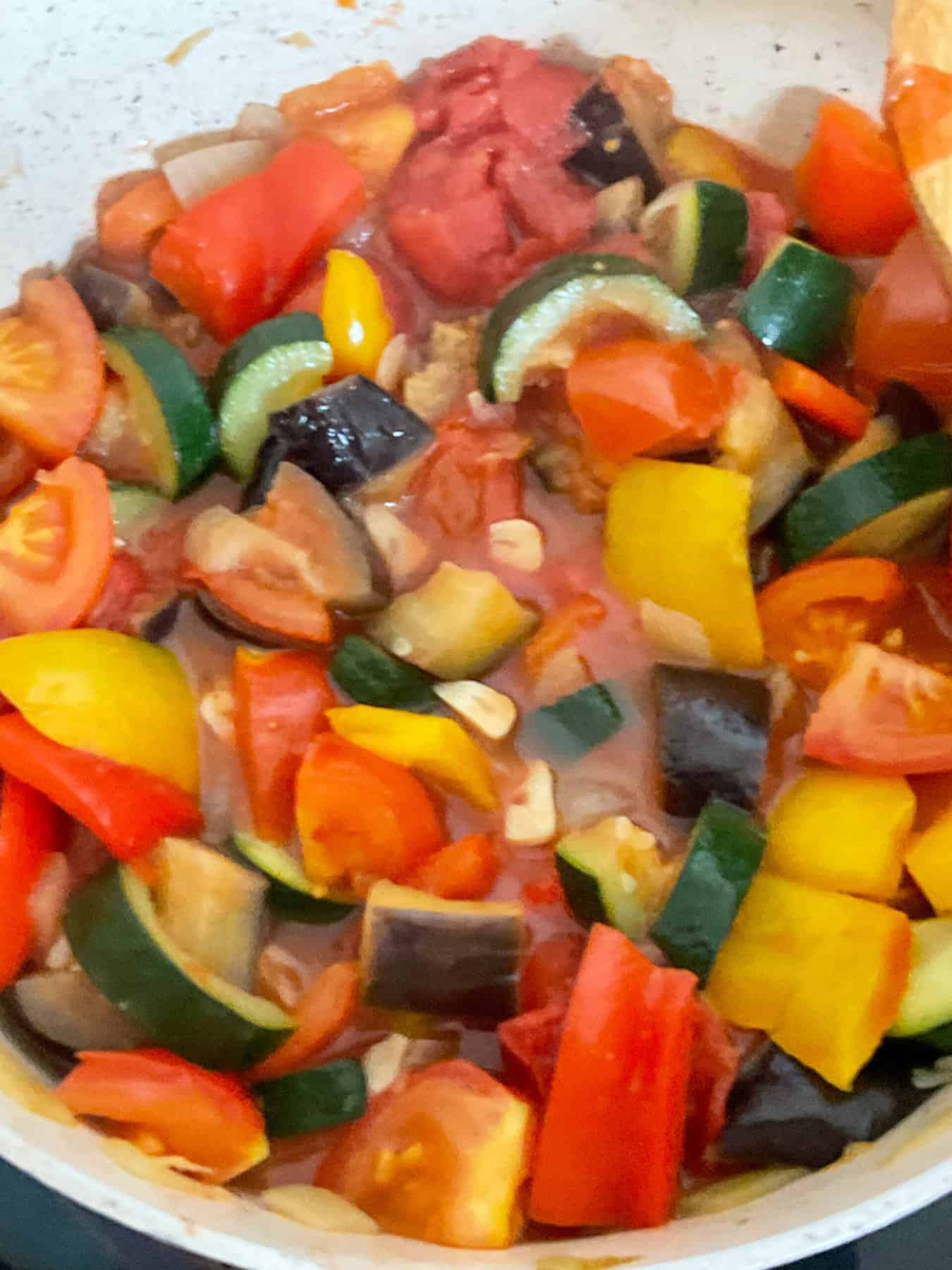
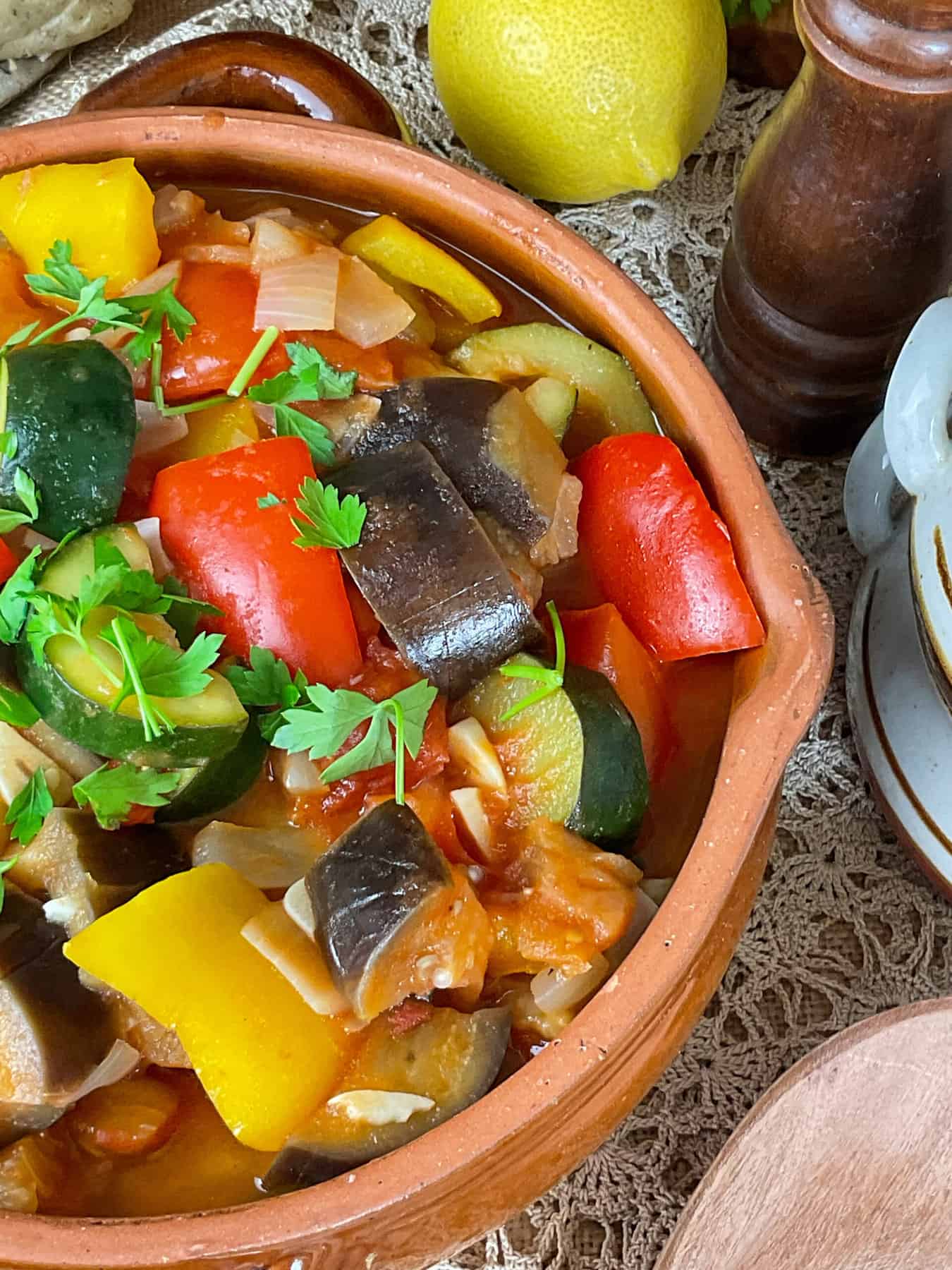
Stir through the sugar, and add enough salt and pepper to bring the flavours together. Stir through some dried mixed herbs [a French mix if possible], and garnish with fresh parsley or basil leaves.
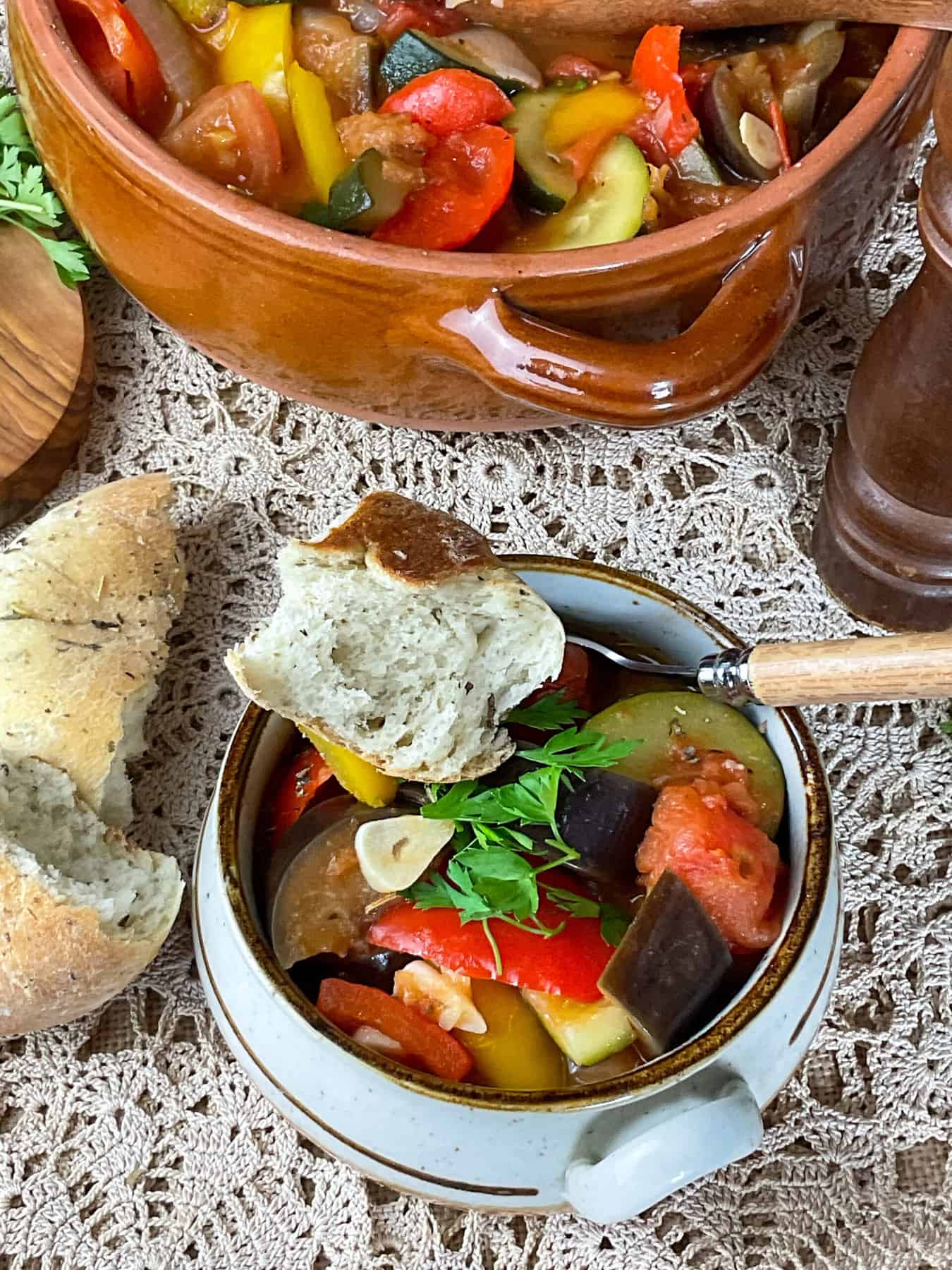
A squeeze of fresh lemon juice is a tasty addition to each bowl of ratatouille as is an extra sprinkling of mixed dried herbs.
Enjoy a bowl of rustic ratatouille with crusty bread rolls or chunks of crusty bread to mop up the delicious vegetable juices that this ratatouille recipe provides. This recipe does not result in a dry ratatouille, veggie stew juices are just too tasty.
[The bread rolls in the above image were prepared in my bread maker and are a simple bread roll recipe with French dried mixed herbs added to the dough.]
Recipe notes and FAQ
Storage
Leftover ratatouille can be stored within the refrigerator in a covered container for up to 4 days. Or frozen for 2-3 months although do keep in mind that the texture of the veggies may change slightly.
Reheating
Leftover ratatouille can be added to a non-stick pot and brought to a gentle simmer on the stove-top. Reheat for 2-3 minutes or longer until the stew is piping hot throughout. Stir frequently as the stew reheats.
Or microwave the ratatouille in a microwave safe dish and add a loose lid made from microwave safe food wrap or a plastic microwave lid placed loosely over the top so that steam can escape. Reheat in 1-2 minute bursts, stirring each time, and repeating until the veggies are very hot. Leave the stew for a minute to sit as it will continue to reheat once out of the microwave.
Alternatively enjoy the leftover ratatouille chilled straight from the refrigerator, it is delicious as a topping for crackers or oatcakes, or used as a side rather like a chunky salsa.
Yes! Ratatouille is naturally gluten-free as its main ingredients are simply vegetables. Although if you use a dried herb seasoning mix check to see if they have any gluten containing ingredients.
Preparing ratatouille in advance is a great idea as then the flavours get a chance to meld together and develop further. Also ratatouille can be eaten chilled as a snack with bread, crackers, oatcakes, salad, etc., so cooking a batch and storing in the refrigerator is perfect for quick snacks. Plus it reheats easily.
Pasta, mashed potatoes, any cooked grain such as barley, rice, couscous, millet, quinoa, salad, creamy polenta or polenta chips, vegan cheese board, crusty bread, baguette, garlic bread, and vegan sausages, Vegan Meatloaf, or Crispy Tofu Bites are all tasty accompaniments.
Eat it! No seriously, leftover ratatouille is amazing straight from the refrigerator for an easy nutritious snack. Think of it like a relish or a chunky salsa. Scottish Oatcakes topped with ratatouille are just delicious, as are any cracker, crusty bread or slices of baguette. Or pair the ratatouille with a freshly cooked 3 Ingredient Flatbread.
A few more ideas:
* Pasta sauce: simply heat the ratatouille and serve it over pasta, spaghetti, thick noodles, or rice, couscous, quinoa, etc
* On toast: enjoy the hot ratatouille over a slice of toasted bread, perfect for an easy lunch
* Bruschetta: Top slices of toasted baguette with the ratatouille to create tasty bruschetta snacks which are also tasty for a starter meal or aperitif.
* Soup: Add the ratatouille to a vegetable soup such as Minestrone or
Italian Cabbage and Bean Soup, for an instant flavour boost. Likewise add it to a Mediterranean stew such as this Spanish Chickpea Stew, either stir the ratatouille through the soup or stew or use it as a topping or side-dish.
* Pizza topping: Add pieces of the ratatouille vegetables to a home-made or shop-bought pizza and bake the pizza as usual, the veggies provide delicious flavour pops.
* Blend the ratatouille and serve as a chilled soup similar to the chilled Spanish tomato soup Gazpacho, perfect for hot summer days. You may need to add vegetable broth or perhaps tomato juice, to the ratatouille so that it can be blended easier into a smooth soup.
* Sandwich filling: drain any of the tomato juices and use the vegetable pieces as a filling for a sandwich or a vegan toasted cheese sandwich.
* Enjoy the chilled ratatouille as an additional element to this vegan Ploughman's Sandwich or Lunch Platter, ideal for a picnic.
* Add chilli flavourings to the ratatouille such as chilli powder, cumin, and paprika and stew the flavours together for an extra quick vegan chilli dinner.
* Stir some cooked vegan mince through the ratatouille and heat all the flavours together, and serve with spaghetti pasta for a speedy spaghetti Bolognese.
Of course, many people dislike the texture of aubergines which are also known as eggplants, so its perfectly fine to omit the aubergine from a ratatouille. The simplest idea is to increase the amount of the other vegetables particularly the courgette and bell pepper.
Courgettes [Zucchini]: Courgette has a similar texture to aubergine when cooked.
Mushrooms: Mushrooms can work well due to their meaty texture,
Bell Peppers: While they have a different texture, bell peppers bring a nice sweetness and texture.
Butternut Squash, Acorn Squash, Pumpkin: These can bring a different flavour profile, but the their texture can be similar to cooked aubergine, however do bear in mind that the squash may take longer to soften so pre-cooking the squash until its nearly tender may be a good idea before adding to the recipe.
Summer Squash, Yellow Squash, Vegetable Marrow: These are similar in texture to aubergine and so can add a similar look to the ratatouille.
Firm Tofu: This might be a less conventional substitute, but tofu is excellent at absorbing flavours and can add a protein boost.
Salting aubergines (or eggplants) is an old practise, and whether or not it's necessary depends on a few things.
Aubergines were traditionally salted to reduce their bitterness as older eggplant varieties had a more bitter flavour, and salting would pull out the bitter juices. However, because most modern eggplant types have been developed to be less bitter, this step is frequently unnecessary for flavour reasons.
Another reason that aubergines were salted was that they can be made less absorbent by salting them. During cooking, aubergines absorb a lot of oil, much like sponges. By salting the aubergines first, the cell walls crumbled, making them less prone to absorbing oil.
Whether or not to salt your aubergines for ratatouille depends on your cooking method. If you're cooking the aubergines separately from the other vegetables, salting them can help keep them from absorbing too much oil.
However, if you're going to simmer all of the vegetables together salting is probably not necessary.
Salting aubergines, also known as "sweating" them, is a straightforward process but not really required, but for your information here's a simple guide:
1. Slice or Dice: First, slice or dice the aubergines according to your recipe. Some recipes might call for thick slices, while others might require small cubes.
2. Salt: Next, sprinkle the aubergine pieces with salt. Make sure to cover all the cut surfaces. You don't need a ton of salt—just enough to lightly cover the surfaces.
3. Rest: Allow the salted aubergine to sit for about 30 minutes. You can place it in a colander or on a cooling rack set over a baking sheet to catch any liquid that is drawn out. During this time, you should see beads of liquid forming on the surface of the aubergine. This is the water being drawn out by the salt.
4. Rinse and Dry: After the aubergine has rested, rinse the pieces under cold water to remove the salt. Be sure to rinse well, otherwise the aubergine might end up too salty. After rinsing, pat the aubergine dry with a clean towel or piece of kitchen roll.
5. Cook: Now your aubergine is ready to be cooked according to your recipe.
Remember, the purpose of this process is to draw out some of the water content of the aubergine, which can reduce bitterness and prevent the aubergine from absorbing too much oil during cooking.
However, many modern varieties of aubergine are less bitter than older ones, so this step isn't always necessary. You can choose to do it or not depending on your personal preference and the specific recipe you're following.
The simple answer is to use the aubergines immediately after preparing them for a recipe, so just cut them before required. However, life happens and if you can't use the prepared aubergine straight away there are a few things you can try to reduce the oxidation that is caused by the oxygen in the air reacting with the aubergine enzymes.
1. Rub lemon juice over the exposed aubergine and store within the refrigerator, perhaps in a food bag.
2. Place the aubergine pieces into a cold bowl of water which has had a few tablespoons of vinegar or lemon juice added, keep the aubergine in the water until required.
3. Use a food vacuum sealer to seal the aubergine pieces into a food storage bag, keep the bag in the refrigerator.
4. Wrap the pieces of aubergine tightly in food wrap to try prevent any more air being exposed to the cut aubergine.
5. Try blanching the aubergine pieces in a bowl of boiling water which may stop the enzymatic reaction.
If nothing works don't panic! The aubergine is fine to cook and eat even if it does go brown and the flavour will not go bad. Simply cook the aubergine as soon as you are able.
Of course not. Traditional ratatouille recipes tend to skin and de-seed the tomatoes as this can have a variety of benefits such as better appearance, less chewy tomatoes, better texture as softer seed insides are removed, and perhaps a sweeter ratatouille as some of the tomatoes acidity is removed.
For our recipe the tomatoes are simply chopped without being skinned and deseeded and the result is a delicious quick and easy rustic style ratatouille that is not adversely affected with the tomato skins and seeds left on.
If you prefer to skin your tomatoes then here is an easy guide that offers two methods:
Method 1:
1. Using a large pot, fill it with water and bring it to the boil.
2. Score an X onto the base of each tomato.
3. Gently drop the tomatoes into the boiling water for 30-60 seconds, or until the skins start to peel back.
4. Immediately transfer the tomatoes to a bowl of ice water to stop the cooking process.
5. After a few minutes remove each tomato and peel the skins off.
6. Slice each tomato into two pieces and scoop out the seeds.
Method 2:
1.Preheat the oven to 180 Fan, 200C, Gas 6, 400F.
2. Score an X onto the base of each tomato.
3. Place the tomatoes on a baking sheet and roast for 20-25 minutes, or until the skins start to blister and peel back.
4. Cool the tomatoes and then peel the skins off.
5. Slice each tomato into two pieces and scoop out the seeds.
Tips:
If you are using very ripe tomatoes, you may not need to peel them.
If you are using very firm tomatoes, you may need to roast them for a longer period of time.
You can also use a paring knife to remove the seeds from the tomatoes.
Once the tomatoes are skinned and deseeded, you can add them to your ratatouille recipe.
For this recipe we use salad tomatoes as they are often the cheapest tomato option available in the UK.
"Salad tomatoes" is a term often used in the UK to describe a type of tomato that is a good all-rounder and used for a variety of purposes especially salads. They are generally medium-sized, round, and have a good balance of sweetness and acidity. They are similar to what might be called "round" or "globe" tomatoes in other places.
In other countries, the term "salad tomatoes" isn't necessarily used, but there are certainly equivalent varieties available. The type and names of tomatoes can vary greatly from one country or region to another, due to local preferences and growing conditions. In the U.S., for example, a common variety for salads might be called "beefsteak" or "vine-ripened". In Italy, you might find "Roma" tomatoes (also known as "plum tomatoes") used in salads and other dishes.
However, the concept of a "salad tomato" is pretty universal - it's essentially a fresh, tasty tomato that can be sliced and used raw in salads. You'll find suitable varieties in supermarkets, farmers' markets, and grocery stores around the world, even if they're not specifically labeled as "salad tomatoes".
Absolutely, the best type of tomato for a ratatouille is the ones that you have easily available.
Riper tomatoes are juicer and will provide a better flavour for the ratatouille so perhaps wait until any firm tomatoes that you have, are given the chance to ripen up a little before using.
Keep the firm tomatoes out of the refrigerator for a few days to help them ripen quicker. Some people prefer a meatier Roma or plum tomato for cooking in a stew as they have less seeds and water content.
Look out for any reduced price packs of tomatoes in your local store or supermarket as these are ideal for using up in a batch of home-made ratatouille.
Ratatouille is a Provençal dish so it usually features herbs common to that region of France. Here are some you can consider:
Herbs to add during cooking the ratatouille:
Thyme: This herb adds a subtle earthy flavour that is not overpowering and pairs well with all the vegetables in ratatouille.
Rosemary: A little goes a long way with rosemary. It has a strong, pine-like flavour that complements the tomatoes and eggplant.
Bay Leaves: These are typically added during the cooking process and then removed before serving. They add a subtle depth to the flavours.
Herbs de Provence: This is a blend of herbs typically used in the Provence region of France. It usually includes thyme, rosemary, marjoram, and oregano, and sometimes lavender.
Herbs to add as a garnish:
Basil: This is a common garnish for ratatouille. It adds a fresh, slightly sweet flavour that complements the other ingredients.
Parsley: Freshly chopped parsley can add a touch of brightness and colour to the ratatouille.
Chervil: Less common, but chervil has a delicate flavour that's a cross between parsley and tarragon.
Even less common is to add a dash of dried mixed herbs or Herbs de Provence to each serving of ratatouille just before eating as that way the flavours of the dried herbs are more pronounced.
Of course, its an easy task to mix a few dried herbs together to create your own French dried herb mix. The Provençal dried herb mix that we use for this recipe was sourced from The Grape Tree health store [Inverness, Scotland] and is titled Herbs De Provence [80g] and contains basil, marjoram, rosemary and thyme.
Here's a simple recipe that can be easily adjusted to suit your preferences and what dried herbs you have available, also feel free to reduce the amounts given to prepare a smaller batch of dried herbs:
Ingredients:
1-2 tablespoons dried rosemary
1-2 tablespoons dried thyme
1-2 tablespoons dried marjoram
1-2 tablespoons dried basil
These dried herbs are an optional addition:
1-2 tablespoons dried oregano
1-2 tablespoons dried savory
1 teaspoon dried lavender (optional)
Instructions:
1. Combine all the dried herbs in a bowl and mix well.
2. Store your homemade Herbs de Provence in an airtight container away from heat and light, and it should be fine for up to a year or longer. If you have an empty shop-bought herb jar then this would be perfect to store your home-made herb mix.
3. You can use this mix in many French and Mediterranean dishes as well as ratatouille, such as Spanish Chickpea Stew, Minestrone, and other vegetable stews and soups.
***Please note that the use of lavender is a matter of personal preference and is more typical of US versions of Herbs de Provence.***
In France, lavender is not traditionally part of the mix. Also, personally I would not add lavender to the mix but I may just be a wimp as it could actually taste amazing!
Do let us know if you like dried lavender in your ratatouille or other vegan Mediterranean recipe!

The garlic for this French vegan recipe is simply prepared by slicing it, rather than mincing or fine dicing, as with the bigger pieces of garlic the garlic can actually be tasted and is part of the stew rather than melting away. Of course, fine dice your garlic if preferred.
Ratatouille cooking tips
These ratatouille cooking tips will help you cook the best ratatouille possible.
- Use ripe vegetables. Ripe vegetables will have the best flavor and texture. Look for courgettes, aubergines, bell peppers and tomatoes that may be on the reduced section of the supermarket or store as then they will be nice and ripe.
- Don't overcook the vegetables. Ratatouille is best when the vegetables are still slightly crunchy.
- Use olive oil as it will provide the best authentic flavour and richness to the dish.
- Season with salt and pepper to taste. The seasoning brings the fresh flavours together and helps highlight them to their best abilities.
- Add the seasoning at the end of cooking, especially if your preparing a quick ratatouille like this recipe. Adding salt too early in the cooking will draw the vegetables natural water out and the ratatouille will likely be too watery at the end of cooking.
- Add a little dash of sugar as this can help highlight the vegetables natural sweetness, and if you've used canned tomatoes the sugar also balances the tomatoes if they are overly acidic.
- Serve hot or cold, ratatouille is a versatile dish that can be enjoyed either way.
- Save time by pre-cutting the bell peppers, tomatoes, onions and garlic.
- Its best to prep the courgette and aubergine just before using as once cut the flesh of these veggies reacts to the air and starts to brown.
- For additional flavour add fresh herbs to the ratatouille during cooking, such as a sprig of rosemary, thyme, oregano, parsley, etc.
- If using basil, to preserve the flavour stir the leaves through the ratatouille at the end of cooking or scatter over the finished ratatouille.
More vegan Mediterranean recipes
These recipes are inspired by the beautiful ingredients that highlight the best of the Mediterranean diet.
For more tasty dinner and lunch ideas check out our growing collections of Vegan Dinner Recipes and Vegan Lunch Recipes.
***please note: for US measurements click the 'US customary button' within the recipe and the measurements will switch to tablespoons, cups, and ounces.***
📖 Recipe
Easy and Quick Ratatouille
Equipment
- Large soup or stew pot, non-stick with lid
Ingredients
- 2 tablespoon olive oil
- 1 medium aubergine [eggplant] chopped into large chunks 1-1½ inch pieces [total weight of aubergine before prepping was 350 grams]
- 1 medium courgette [zucchini] chopped into rough bite-sized pieces [slice lengthways then cut each slice into thick chunks 1-1½ inch pieces [total weight of courgette before prepping was 260 grams]
- 6 salad tomatoes halved and then each half quartered [total weight was 450 grams tomatoes]
- 1 medium red bell pepper chopped into chunky 1-1½ inch pieces [weight after prep was 150 grams]
- 1 medium yellow bell pepper chopped into chunky 1-1½ inch pieces [weight after prep was 180 grams]
- 4 large garlic cloves sliced [if your cloves are small use a few extra]
- 2 medium onions rough chopped
- 1 can plum tomatoes 400g [14oz cans]
- 1 teaspoon granulated sugar
- 1 tablespoon dried mixed herbs use a French mixed herb seasoning if available, [can also add fresh herbs if you have them such as a sprig of rosemary or thyme]
Optional:
- small bunch of fresh parsley or basil leaves, half a fresh lemon, extra mixed dried herbs
Instructions
- Heat the oil in a large non-stick pot over a medium heat.2 tablespoon olive oil
- Add the onions and cook for 5 minutes, stirring frequently.2 medium onions
- Next add the chunks of bell pepper, garlic, courgette, aubergine, and stir these with the onions.Cook for a further 10 minutes over a medium heat, with the lid on the pot. Give it a quick stir 3-4 times whilst cooking.1 medium aubergine [eggplant], 1 medium courgette [zucchini], 1 medium red bell pepper, 1 medium yellow bell pepper, 4 large garlic cloves
- Next add the chopped fresh tomatoes, give the stew a stir and pop the lid back on the pot. Cook for 5 minutes, stirring half way through.6 salad tomatoes
- Next, add the canned plum tomatoes, and break each plum tomato into 2 pieces with your mixing spoon,and stir well, cooking for a further 5 minutes, with the lid off. [The vegetables will still have a pleasant bite but will be soft when the ratatouille is cooked. If you prefer a much softer vegetable then cook for a little longer until the texture is to your liking.]1 can plum tomatoes
- Remove the pot from the heat and stir through the sugar, Add enough salt and pepper to taste and to bring all the flavours together.Sprinkle the mixed dried herbs over the finished dish and stir through the stew. A squeeze of fresh lemon juice is optional but does add a zesty kick.1 teaspoon granulated sugar, 1 tablespoon dried mixed herbs
- This ratatouille recipe is not a dry recipe as it results in veggie stew juices that are delicious mopped up with bread.
- Garnish with fresh parsley or basil.small bunch of fresh parsley or basil leaves, half a fresh lemon, extra mixed dried herbs
- Ratatouille can be enjoyed hot or cold, and an extra sprinkling of mixed dried herbs added to the top of each bowl, especially a French herb mix, adds a tasty flavour boost.A wedge of crusty bread and a crisp salad are perfect accompaniments.
Notes
- Nutritional information is provided for guidance only and is not intended to be an exact calculation. Data does not include the fresh herb garnish or the optional fresh lemon juice.
- Store leftovers for up to 3 days, within a covered container, and placed in the refrigerator.
- Leftovers can be frozen for 2-3 months but the texture will change.
- Leftovers can be reheated by adding to a non-stick pot and bringing to a gentle boil. Reheat for 2-3 minutes stirring frequently.
- Or microwave until piping hot, stirring after each 1-2 minutes of cooking.
- The vegetables do not have to be chopped perfectly.
- Any type of fresh tomatoes can be used.
- Use canned plum tomatoes if possible as they have the best flavour for this recipe and they retain their shape once cooked. I just used Asda value plum tomatoes, but of course any brand is fine.
- If your not a fan of aubergine or eggplant then simply omit and replace with more of the other vegetables, or replace with yellow/summer squash, vegetable marrow, mushrooms or even tofu cubes.
- To encourage kids to eat their vegetables why not watch the Ratatouille animation film and then have a fun ratatouille family cooking session!
- If the textures of some of the vegetables are not liked [I've been there many times with my kids!] then certain family members ratatouille can be blended into a smooth pasta sauce and stirred through some pasta. That's what I usually do with fussy family members!
- If blending the ratatouille then add enough water or vegetable broth so that it blends more easily. I use a stick immersion blender, and in fact have just blended the ratatouille for one of my kids dinners today, and served it on top of wholemeal spaghetti, sprinkled nutritional yeast flakes over, and toasted a herb flavoured roll for the side. All was quickly eaten!
Nutrition
Thank you for trying out our Easy and Quick Ratatouille Recipe!
If you tried this recipe, please let us know in the comments below how it turned out for you, or if you made any modifications.
If you share your creations on social media, don't forget to tag us (@traditionalplantbasedcooking) and use the hashtag #traditionalplantbasedcooking, so we can see your delicious dishes!
Lastly, if you found this recipe helpful, please share it with your friends and family, so they can enjoy it too.
As always, Thank you, and happy cooking!
Love, Jacq x
Leave a Reply